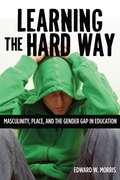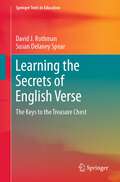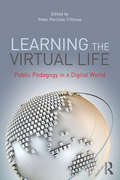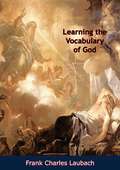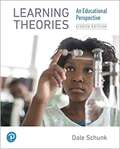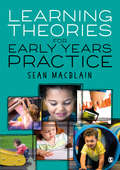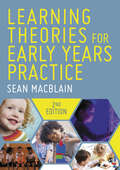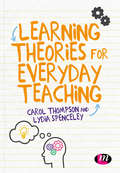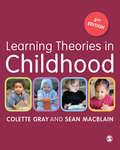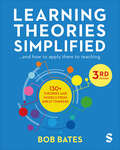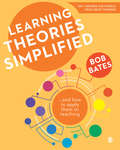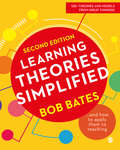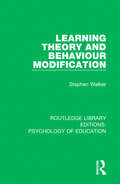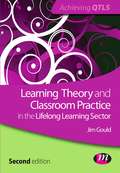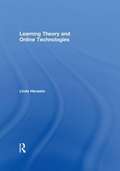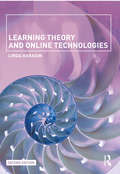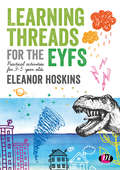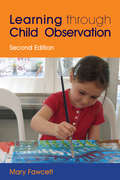- Table View
- List View
Learning the Hard Way: Masculinity, Place, and the Gender Gap in Education
by Edward W. MorrisAn avalanche of recent newspapers, weekly newsmagazines, scholarly journals, and academic books has helped to spark a heated debate by publishing warnings of a "boy crisis" in which male students at all academic levels have begun falling behind their female peers. In Learning the Hard Way, Edward W. Morris explores and analyzes detailed ethnographic data on this purported gender gap between boys and girls in educational achievement at two low-income high schools--one rural and predominantly white, the other urban and mostly African American. Crucial questions arose from his study of gender at these two schools. Why did boys tend to show less interest in and more defiance toward school? Why did girls significantly outperform boys at both schools? Why did people at the schools still describe boys as especially "smart"? Morris examines these questions and, in the process, illuminates connections of gender to race, class, and place. This book is not simply about the educational troubles of boys, but the troubled and complex experience of gender in school. It reveals how particular race, class, and geographical experiences shape masculinity and femininity in ways that affect academic performance. His findings add a new perspective to the "gender gap" in achievement.
Learning the Secrets of English Verse: The Keys to the Treasure Chest (Springer Texts in Education)
by David J. Rothman Susan Delaney SpearThis textbook teaches the writing of poetry by examining all the major verse forms and repeating stanza forms in English. It provides students with the tools to compose successful lines of poetry and focuses on meter (including free verse), rhythm, rhyme, and the many other tools a poet needs to create both music and meaningfulness in an artful poem. Presenting copious examples from strong poets of the past and present along with many recent student examples, all of which are scanned, each chapter offers lessons in poetic history and the practice of writing verse, along with giving students a structured opportunity to experiment writing in all the forms discussed. In Part 1, Rothman and Spear begin at the beginning, with Anglo-Saxon Strong Stress Alliterative Meter and examine every major meter in English, up to and including the free verse forms of modern and contemporary poetry. Part 2 presents a close examination of stanza forms that moves from the simple to the complex, beginning with couplets and ending with the 14-line Eugene Onegin stanza. The goal of the book is to give students the essential skills to understand how any line of poetry in English may have been composed, the better to enjoy them and then also write their own: the keys to the treasure chest. Rothman and Spear present a rigorous curriculum that teaches the craft of poetry through a systematic examination and practice of the major English meters and verse forms. Under their guidance, students hone their craft while studying the rich traditions and innovations of poets writing in English. Suitable for high school students and beyond. I studied with Rothman in graduate school and went through this course with additional scholarly material. This book will help students develop a keen ear for the music of the English language.—Teow Lim Goh, author of Islanders
Learning the Virtual Life: Public Pedagogy in a Digital World
by Peter Pericles TrifonasDigital technologies have transformed cultural perceptions of learning and what it means to be literate, expanding the importance of experience alongside interpretation and reflection. Learning the Virtual Life offers ways to consider the local and global effects of digital media on educational environments, as well as the cultural transformations of how we now define learning and literacy. While some have welcomed the educational challenges of digital culture and emphasized its possibilities for individual emancipation and social transformation in the new information age, others accuse digital culture of absorbing its recipients in an all-pervasive virtual world. Unlike most accounts of the educational and cultural consequences of digital culture, Learning the Virtual Life presents a neutral, advanced introduction to the key issues involved with the integration of digital culture and education. This edited collection presents international perspectives on a wide range of issues, and each chapter combines upper-level theory with "real-world" practice, making this essential reading for all those interested in digital media and education.
Learning the Vocabulary of God: A Spiritual Diary
by Frank Charles LaubachFrank Charles Laubach was an Evangelical Christian missionary and mystic known as "The Apostle to the Illiterates." It was a daily record of an effort to hear God's instructions, minute by minute, and to carry them out in a new, creative field which was far beyond anything the author had undertaken.-Print ed.
Learning Theories: An Educational Perspective
by Dale SchunkA comprehensive look at the key theoretical principles, concepts, and research findings about learning, with special attention paid to how these concepts and principles can be applied in today’s classrooms. <p><p> This widely used and respected resource introduces readers to the key theoretical principles, concepts, and research findings about learning and helps them see how to apply that theory and research as educators. Learning Theories begins with a discussion of the relationship between learning theory and instruction. It then looks at the neuroscience of learning. Six chapters cover the major theories of learning ― behaviorism, social cognitive theory, information processing theory, cognitive learning processes, and constructivism. The following three chapters cover key topics related to learning ― motivation, self-regulated learning, and contextual influences. And the final chapter, Next Steps, helps students consolidate their views about learning. The 8th Edition has been significantly updated with a number of new features and the most current thinking and research.
Learning Theories for Early Years Practice
by Sean MacBlainUnderstanding and applying learning theories is crucial to the transition from study or training, to practice in a real-world setting. This new textbook will prepare the reader by demonstrating how key learning theories pan out in practice, with the aid of photographs, examples and clear explanations. Divided into three main sections, Early Influences, Modern Influences, and Challenges for Theorists in a Changing World, this author identifies the key theorists in early childhood, past and present, before linking them to the main issues and developments that face early years practitioners today. An explanation of each key theorist is guided by a clear structure, including: links to other theorists strengths and weaknesses of the theory the theory in practice Packed full of case studies, activities, points for discussion, extended and recommended reading, this is a fantastic resource for students and teachers who want to build a strong foundation in learning theories, to enable them to support the young children in their care as effectively as possible.
Learning Theories for Early Years Practice
by Sean MacBlainUnderstanding and applying learning theories is crucial to the transition from study or training, to practice in a real-world setting. This new textbook will prepare the reader by demonstrating how key learning theories pan out in practice, with the aid of photographs, examples and clear explanations. Divided into three main sections, Early Influences, Modern Influences, and Challenges for Theorists in a Changing World, this author identifies the key theorists in early childhood, past and present, before linking them to the main issues and developments that face early years practitioners today. An explanation of each key theorist is guided by a clear structure, including: links to other theorists strengths and weaknesses of the theory the theory in practice Packed full of case studies, activities, points for discussion, extended and recommended reading, this is a fantastic resource for students and teachers who want to build a strong foundation in learning theories, to enable them to support the young children in their care as effectively as possible.
Learning Theories for Early Years Practice
by Sean MacBlainThe perfect guide for students who need to get to grips with learning theories and how they relate to the early years, this book covers Early and Modern theorists and their theories, and how they apply today. Bursting with full colour photographs, case studies, activities and discussion points, each chapter explores the theorist and the theory; what the theory looks like in practice; the strengths and weaknesses of each theory; and its links to other theorists. This new edition includes: Three new chapters on Bowlby, Dweck and Claxton New reflective activities New critical questions following the case studies
Learning Theories for Early Years Practice
by Sean MacBlainThe perfect guide for students who need to get to grips with learning theories and how they relate to the early years, this book covers Early and Modern theorists and their theories, and how they apply today. Bursting with full colour photographs, case studies, activities and discussion points, each chapter explores the theorist and the theory; what the theory looks like in practice; the strengths and weaknesses of each theory; and its links to other theorists. This new edition includes: Three new chapters on Bowlby, Dweck and Claxton New reflective activities New critical questions following the case studies
Learning Theories for Everyday Teaching
by Carol Thompson Lydia SpenceleyAn essential tool for new teachers and trainees who want to use learning theories to develop their practice. The text explores key learning theories in a pragmatic way and encourages focused reflection to promote critical analysis of theories and their potential application to specific contexts. The authors highlight the practical benefits of using theory in planning, teaching and reflecting on practice. The text also encourages the use of a range of creative approaches to enhance learning. Each chapter explores a key aspect of the teacher's role (such as planning, motivation or assessment) and outlines theories relating to this theme - fully embedding the use of learning theories in practical every day teaching. It includes activities for reflection and a section encouraging readers to 'map' the theory to their own practice. Scenarios and case studies throughout illustrate learning and support readers link theory to practice.
Learning Theories for Everyday Teaching
by Carol Thompson Lydia SpenceleyAn essential tool for new teachers and trainees who want to use learning theories to develop their practice. The text explores key learning theories in a pragmatic way and encourages focused reflection to promote critical analysis of theories and their potential application to specific contexts. The authors highlight the practical benefits of using theory in planning, teaching and reflecting on practice. The text also encourages the use of a range of creative approaches to enhance learning. Each chapter explores a key aspect of the teacher's role (such as planning, motivation or assessment) and outlines theories relating to this theme - fully embedding the use of learning theories in practical every day teaching. It includes activities for reflection and a section encouraging readers to 'map' the theory to their own practice. Scenarios and case studies throughout illustrate learning and support readers link theory to practice.
Learning Theories in Childhood
by Sean Macblain Colette GrayBy focusing on the early philosophies of learning and the key behavioural, cognitive and social theorists, this book provides a comprehensive overview of children's learning. The authors discuss the key learning theories, highlight the strengths and weaknesses of each approach and encourage reflection on how different approaches impact on the learning environment. The discussion finishes with an exploration of the new sociology of childhood. Examples are drawn from practice to highlight key concepts, and to make vital links between theory and practice.<P><P> Theorists considered include:<P> - Locke<P> - Rousseau<P> - Montesori<P> - Piaget<P> - Vygotsky<P> - Bandura<P> - Bronfenbrenner <P> - Bruner<P> Accessibly written, with key questions and recommended reading included, this book is essential reading for all those studying on child development, early childhood and childhood studies courses, and for anyone interested in understanding more about how children learn and think.<P> Colette Gray is Principal Lecturer in Early Childhood Education at Stranmillis University.<P> Dr Sean MacBlain is Reader in Child Development and Disability at University College Plymouth, St. Mark & St. John.
Learning Theories Simplified: ...and how to apply them to teaching
by Bob BatesAre you struggling to get your head around John Dewey’s educational pragmatism? What exactly is Jean Piaget saying about cognitive development? Maybe you’re running out of time and patience making sense of Rosenshine′s Principles of Instruction? Have you reached breaking point reading Daniel T. Willingham on educational neuroscience? Written for busy teachers, students, trainers, managers and , this ′dip-in, dip-out′ guide makes theories of learning accessible and practical. It explores 134 classic and contemporary learning theorists in an easy-to-use, bite-sized format with clear relevant illustrations on how each theory will benefit teaching and learning. Each model or theory is explained in less than 350 words, followed by a ′how to use it′ section. New to this third edition: New section on cognitive learning theory, including Arthur Shimamura, Alison Gopnik, John Flavell and more Enhanced critical perspectives offering a deeper examination of each theory′s strengths and weaknesses A new entry on Gloria Ladson-Billings and Critical Race Theory in education
Learning Theories Simplified: ...and how to apply them to teaching
by Bob BatesAre you struggling to get your head around John Dewey’s educational pragmatism? What exactly is Jean Piaget saying about cognitive development? Maybe you’re running out of time and patience making sense of Rosenshine′s Principles of Instruction? Have you reached breaking point reading Daniel T. Willingham on educational neuroscience? Written for busy teachers, students, trainers, managers and , this ′dip-in, dip-out′ guide makes theories of learning accessible and practical. It explores 134 classic and contemporary learning theorists in an easy-to-use, bite-sized format with clear relevant illustrations on how each theory will benefit teaching and learning. Each model or theory is explained in less than 350 words, followed by a ′how to use it′ section. New to this third edition: New section on cognitive learning theory, including Arthur Shimamura, Alison Gopnik, John Flavell and more Enhanced critical perspectives offering a deeper examination of each theory′s strengths and weaknesses A new entry on Gloria Ladson-Billings and Critical Race Theory in education
Learning Theories Simplified: ...and how to apply them to teaching
by Dr Bob BatesAre you struggling to get your head around John Dewey's educational pragmatism? What exactly is Jean Piaget saying about cognitive development? Maybe you're running out of time and patience making sense of Carol Dweck's mindsets? Have you reached breaking point reading Daniel T. Willingham on educational neuroscience? Written for busy teachers, trainers, managers and students, this dip-in dip-out guide makes theories of learning accessible and practical. It explores over 100 classic and contemporary learning theorists in an easy-to-use, bite-sized format with clear relevant illustrations on how each theory will benefit your teaching and learning. Each model or theory is explained in less than 350 words, many with accompanying diagrams, and the 'how to use it' sections, in less than 500 words. Every entry includes: Do it steps in order to apply the theory or model Reflection points & challenges to develop your understanding of how to apply it Analogies & metaphors from which understanding and meaning can be drawn Tips for the classroom Further reading if you want to explore a theory in greater depth.
Learning Theories Simplified: ...and how to apply them to teaching
by Dr Bob BatesAre you struggling to get your head around John Dewey’s educational pragmatism? What exactly is Jean Piaget saying about cognitive development? Maybe you’re running out of time and patience making sense of Carol Dweck’s mindsets? Have you reached breaking point reading Daniel T. Willingham on educational neuroscience? Written for busy teachers, trainers, managers and students, this dip-in dip-out guide makes theories of learning accessible and practical. It explores over 100 classic and contemporary learning theorists in an easy-to-use, bite-sized format with clear relevant illustrations on how each theory will benefit your teaching and learning. Each model or theory is explained in less than 350 words, many with accompanying diagrams, and the ‘how to use it’ sections, in less than 500 words. Every entry includes: Do it steps in order to apply the theory or model Reflection points & challenges to develop your understanding of how to apply it Analogies & metaphors from which understanding and meaning can be drawn Tips for the classroom Further reading if you want to explore a theory in greater depth. More titles by Bob Bates: Educational Leadership Simplified A Quick Guide to Special Needs and Disabilities
Learning Theories Simplified: ...and how to apply them to teaching
by Dr Bob BatesWritten for busy teachers, trainers, managers and students, this 'dip-in, dip-out' guide makes theories of learning accessible and practical. It explores 130 classic and contemporary learning theorists in an easy-to-use, bite-sized format with clear relevant illustrations on how each theory will benefit teaching and learning. Each model or theory is explained in less than 350 words, followed by a 'how to use it' section. This second edition includes: • A new early childhood theorists section • A new communication theories section • Additional ‘on trend’ theorists throughout • New ‘critical view’ features added to each entry
Learning Theories Simplified: ...and how to apply them to teaching
by Dr Bob BatesWritten for busy teachers, trainers, managers and students, this 'dip-in, dip-out' guide makes theories of learning accessible and practical. It explores 130 classic and contemporary learning theorists in an easy-to-use, bite-sized format with clear relevant illustrations on how each theory will benefit teaching and learning. Each model or theory is explained in less than 350 words, followed by a 'how to use it' section. This second edition includes: • A new early childhood theorists section • A new communication theories section • Additional ‘on trend’ theorists throughout • New ‘critical view’ features added to each entry
Learning Theory and Behaviour Modification (Routledge Library Editions: Psychology of Education #47)
by Stephen WalkerThe ability to learn is of crucial importance in human life, but understanding this ability has proved to be difficult. There have been many attempts to formulate scientific theories based on both animal experiments and human experience; and these have been applied to education and the treatment of psychological disturbance, with a certain amount of success. Originally published in 1984, this incisive guide to the research and its outcomes provides the background to one of the most debated topics in psychology today. Learning Theory and Behaviour Modification introduces the work of major figures, such as Pavlov and Skinner, which has strongly influenced theories in educational and clinical psychology, and formed the basis of the techniques known as ‘behaviour modification’. As well as giving examples of these techniques the author relates new ideas about the scope and limits of behaviour modification to recent changes in the views of learning theorists. How much can experiments on animals tell us about human psychology?
Learning Theory and Classroom Practice in the Lifelong Learning Sector (Achieving QTLS Series)
by Jim GouldThis book is a valuable resource for all trainee teachers in the Lifelong Learning Sector who want to further their understanding of learning theories and how these can be applied to their classroom practice. Each learning theory is considered with the implications for planning, teaching, assessment and classroom management in mind and readers are encouraged to think critically about learning theories and the implications of these for classroom practice. This book will help trainees fulfil the criteria for the award of QTLS and, more importantly, encourage them to use learning theories to bring their teaching alive.
Learning Theory and Online Technologies
by Linda HarasimLearning Theory and Online Technologies offers a powerful overview of the current state of elearning, a foundation of its historical roots and growth, and a framework for distinguishing among the major approaches to elearning. It effectively addresses pedagogy (how to design an effective online environment for learning), evaluation (how to know that students are learning), and history (how past research can guide successful online teaching and learning outcomes). An ideal textbook for undergraduate education and communication programs, and Educational Technology Masters, PhD, and Certificate programs, readers will find Learning Theory and Online Technologies provides a synthesis of the key advances in elearning theory, the key frameworks of research, and clearly links theory and research to successful learning practice.
Learning Theory and Online Technologies
by Linda HarasimLearning Theory and Online Technologies offers a powerful overview of the current state of online learning, the foundations of its historical roots and growth, and a framework for distinguishing between the major approaches to online learning. It addresses pedagogy (how to design an effective online environment for learning), evaluation (how to know that students are learning), and history (how past research can guide successful online teaching and learning outcomes). An ideal textbook for undergraduate Education and Communication programs as well as Educational Technology Masters, Ph.D., and Certificate programs, Learning Theory and Online Technologies provides a synthesis of the key advances in online education learning theory and the key frameworks of research, and clearly links theory and research to successful learning practice. This revised second edition updates data on digital media adoption globally, adds a new chapter on connectivism as a learning theory, and updates the chapter on online collaborative learning, renaming the theory as collaborativism and considering the challenges that arise with the growth of artificial intelligence.
Learning Threads for the EYFS: Practical activities for 3-5 year olds
by Eleanor HoskinsThis text offers practical ideas and guidance for activities through which all areas of the EYFS can be delivered. Each chapter presents a different Learning Thread. For each thread, the author details a number of activities, lists effective resources and most importantly explores opportunities for child initiated learning. Ideas for role play areas and further scope for learning in each thread are also covered. The text demonstrates how these activities can be used whilst planning continuous provision. This book also: Demonstrates how activities link to the EYFS framework directly Offers practical guidance on what to do in settings and with children to enhance their learning Shows how learning can be 'blended' as all learning threads offer links across the prime and specific areas.
Learning Threads for the EYFS: Practical activities for 3-5 year olds
by Eleanor HoskinsThis text offers practical ideas and guidance for activities through which all areas of the EYFS can be delivered. Each chapter presents a different Learning Thread. For each thread, the author details a number of activities, lists effective resources and most importantly explores opportunities for child initiated learning. Ideas for role play areas and further scope for learning in each thread are also covered. The text demonstrates how these activities can be used whilst planning continuous provision. This book also: Demonstrates how activities link to the EYFS framework directly Offers practical guidance on what to do in settings and with children to enhance their learning Shows how learning can be 'blended' as all learning threads offer links across the prime and specific areas.
Learning Through Child Observation: Second Edition
by Mary FawcettThis fully-updated second edition of Learning Through Child Observation is a handbook for professionals working in, or students preparing to work in, children's services. This accessible text examines the value of observation, its use in assessment and the practical aspects and methods of observational study. The author focuses on the importance of fully recognising the child's developmental and emotional state when intervening, and the need to see children `holistically' and as unique individuals within the wider context of the family and community. New chapters include Views of Children and Childhood, which draws on European educational and sociological perspectives and highlights the contrasting views of children, and The 'Hundred Languages of Children', which considers the place of creative engagement and multiple forms of expression by children. With new material and updated chapters, this second edition of a popular text will appeal to students and professionals in all children's services, whether in pre-school, schools, social care, mental health or health settings.
